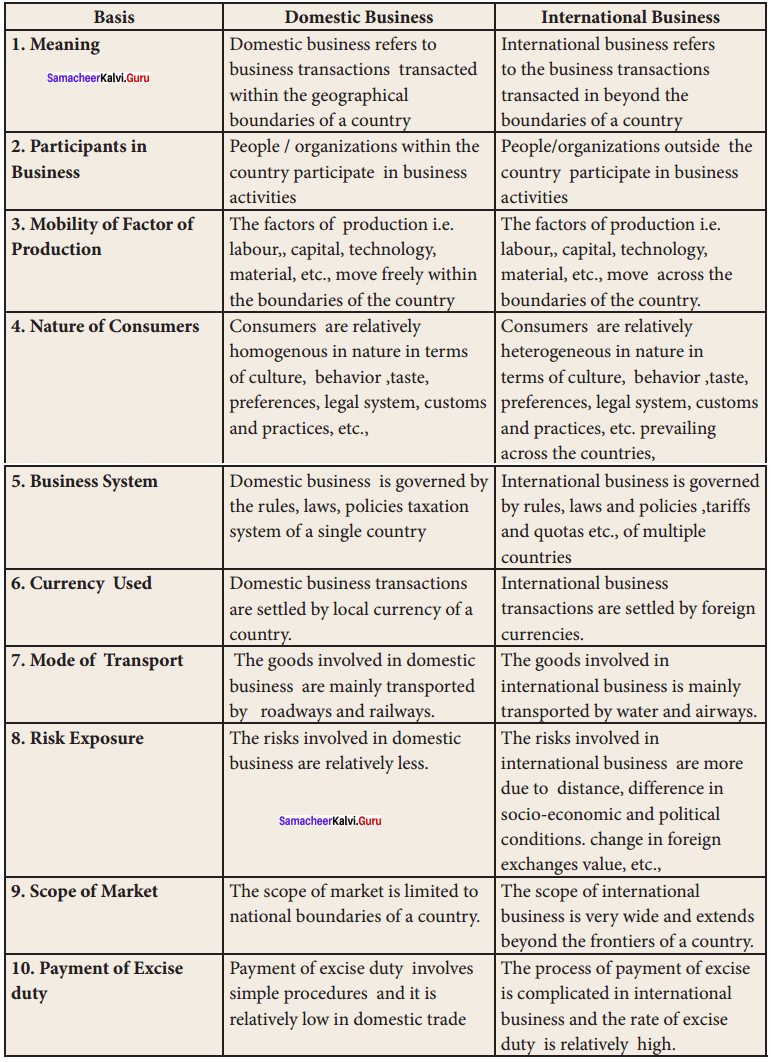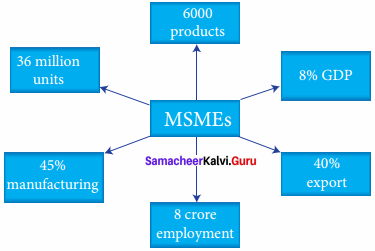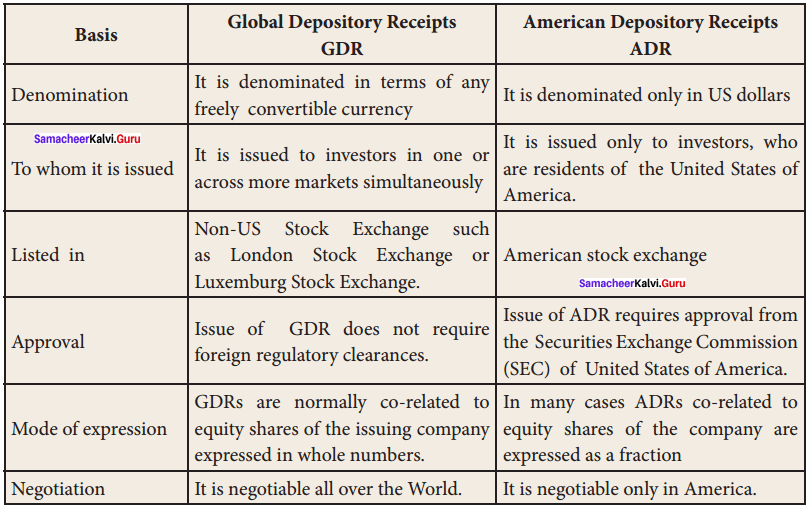Students can find the most related topics which helps them to analyse the concepts if they practice according to the chapter-wise page. It is necessary for the students to practice more Questions and Answers for Tamilnadu State Board Solutions of 11th Commerce are given in the pdf format in chapter 27 Facilitators of International Business Questions and Answers so that students can prepare in both online and offline modes. So, Download Samacheer Kalvi 11th Commerce Book Solutions Questions and Answers, Notes Pdf, to score good marks.
Samacheer Kalvi 11th Commerce Solutions Chapter 27 Facilitators of International Business
Get the Questions and Answers, in Tamilnadu State Board 11th Commerce Solutions for Chapter 27 Facilitators of International Business. Learn the concepts of 11th Commerce Chapter-Wise by referring to the Tamilnadu State Board Solutions for Chapter 27 Facilitators of International Business Questions and Answers. Hence we suggest the students to Download Samacheer Kalvi 11th Commerce Book Solutions Questions and Answers pdf to enhance your knowledge.
Samacheer Kalvi 11th Commerce Facilitators of International Business Textbook Exercise Questions and Answers
I. Choose the Correct Answer
Question 1.
General Agreement on Tariff and Trade was signed on ………………
(a) 30 – October – 1947
(b) 29 – October – 1947
(c) 28 – October – 1947
(d) 26 – October – 1947
Answer:
(a) 30 – October – 1947
Question 2.
WTO was established on ………………
(a) 1 – 1 – 1996
(b) 1 – 1 – 1997
(c) 1 – 1 – 1995
(d) 1 – 1 – 1994
Answer:
(c) 1 – 1 – 1995
Question 3.
The headquarter of WTO is located at ………………
(a) New York
(b) London
(c) Geneva
(d) Brazil
Answer:
(c) Geneva
Question 4.
The day to day administration of WTO is entrusted with ………………
(a) Executive Council
(b) General Council
(c) Administrative Council
(d) General Body
Answer:
(b) General Council
Question 5.
World bank is located at ………………
(a) Washington DC
(b) New York
(c) Tokyo
(d) Hongkong
Answer:
(a) Washington DC
II. Very Short Answer Questions
Question 1.
What is WTO?
Answer:
The World Trade Organisation (WTO) was estabilished on 1st January 1995. The GATT was renamed as WTO with some changes.
Question 2.
What do you mean by World Bank?
Answer:
International Bank for Reconstruction and Development (IBRD) International Bank for Reconstruction and Development is commonly known as World Bank.
Question 3.
What is Special Drawing Rights?
Answer:
Special Drawing Rights (SDR) was created by the IMF in the year 1969 as supplementary international reserve asset. It is described as paper gold.
Question 4.
What is SAARC?
Answer:
South Asian Association for Regional Cooperation is the regional inter governmental organization and geo – political union of nations in South Asia.
Question 5.
What is GATT?
Answer:
The General Agreement on Tariffs and Trade. (GATT) was signed at Geneva on 30th October 1947 by 23 countries. It came into effect on 1st January 1948.
III. Short Answer Questions
Question 1.
What is the primary motive of establishment of WTO?
Answer:
GATT achieved many success but various countries felt the need to create a new international body to replace the GATT. The GATT which remained in force from 1948 to 1994 thus came to an end with the establishment of World Trade Organisation (WTO) on 1st January 1995.
Question 2.
Name the affiliate of World Bank.
Answer:
- International Development Association (IDA)
- International Financial corporation (IFC)
- Multinational Investment Guarantee Agency (MIGA)
- International Centre for Settlement of Investment Disputes (ICSID)
Question 3.
What are the criticisms of World Bank?
Answer:
- Free Trade Benefits Developed Countries more than Developing Countries
- Most Favoured Nation Principles
- Failure to Reduce Tariffs on Agriculture
- Neglect of Farmers Interest in Developing Countries
- Neglect Environmental Considerations
- Neglect of Cultural and Social Factors
- Inability of People in Developing Countries to Buy Life Saving Drugs
Question 4.
How is the value of SDR determined currently?
Answer:
From 1st October 2016 SDR basket consists of US dollar, Euro, the Chinese Renminbi, Japanese Yen and British Pound sterling. The value of SDR is regularly posted daily in IMF website. IMF member can exchange SDR for freely usable currencies by voluntary exchange or as per IMF instructions. Besides members can borrow from IMF at favorable rate of interest to correct imbalance in balance of payments.
Question 5.
Mention the functions of SAARC.
Answer:
- Monitoring and co – ordinating the development programme
- Determining inter – sectoral priorities
- Mobilizing cooperation within and outside the region.
- Dealing with modalities of financing
IV. Long Answer Questions
Question 1.
Point out the objectives of WTO.
Answer:
- Improving the standard of living of people in member countries
- Making optimum utilization of world’s resources for sustainable development of member countries.
- Promoting an integrated more viable and durable trading system in the sphere of international business
- Expansion of trade in goods and services.
- Ensuring full employment and large steady growth volume of real income and effective demand.
- Protecting the environment.
Question 2.
Write down the functions of WTO.
Answer:
- It is a forum for negotiation and formalization of trade agreement among the member countries.
- It settles disputes and grievances relating to trade among the member countries.
- It frames commonly acceptable code of conduct in order to reduce trade barriers.
- It holds consultations with IMF and World Bank (IBRD) and its affiliates to bring about a greater understanding and co – operation in global economic policy making.
- It supervises the operations of agreement relating to General Agreement on Tariffs and Trade(GATT) and Trade-
- Related Intellectual Properties Rights (TRIPS)
- It regulates trade between participating countries.
Question 3.
Describe the benefits of WTO.
Answer:
1. WTO is promoting international peace and creating a conducive environment for conducting international trade.
2. It settles the trade disputes amicably among the member countries.
3. It promotes the standard of living of people by increasing their income level from free trades.
4. WTO has removed quantitative restrictions and non – tariff barriers. It has facilitated free flow of foreign trade among the member countries. The countries can impose import restrictions only to correct balance of payments difficulties and not otherwise.
5. It stimulates economic growth of developing countries by providing them with much needed capital and giving them preferential treatment in trade related matters.
6. WTO organizes periodical regional and international conference. Thus developing countries get opportunity to learn the technicalities, rules and regulations governing world, trade, technical assistance available globally, trade potentials in member countries and so on.
7. WTO gives people across the world a wider choice of goods and broader range of qualities of goods to choose from by promoting free trade among the member countries.
8. WTO has lowered trade barriers and thereby allowed trade to flourish across the world. The increase in trade contributes to increase in national income and personal income of people
9. WTO provides a platform for member countries to establish trade links with one another. In the absence of WTO member countries may have to enter many multilateral agreement with so many countries across the world. It provides a greater access to all nations under one roof.
10. WTO is committed to protecting free trade. It has framed rules on subsidies and dumping.
Question 4.
Highlights the functions of IBRD.
Answer:
- Assisting reconstruction of war – affected countries.
- Promoting economic growth and balanced growth of international business.
- Promoting infrastructural facilities like energy and transportation, road development, etc. in member countries.
- Encouraging agricultural and industrial development in developing countries by providing adequate resources.
- Providing resources for promoting sanitation, education, health care and small scale enterprises in member countries.
- Improving standard of living of people of member countries by providing assistance by removing poverty, raising productivity, providing technical support and conducting research and development.
Question 5.
Write down the functions of IMF.
Answer:
- It acts as short term credit institution at the international level.
- It provides machinery for ordinary adjustments of exchange rates.
- It has a reservoir of currencies of the member countries from which a borrower can borrow currencies of other nations.
- It promotes economic stability and global growth by encouraging countries adopt sound economic and financial policies.
- It offers technical assistance and training to help member countries strengthen and implement effective policies. Technical assistance is offered in formulating banking, fiscal, monetary and exchange policies.
- It helps member countries correct their imbalance in balance of payment.
Question 6.
Explain how far India has benefited from IMF.
Answer:
Free Convertibility of Indian Rupee:
Indian rupee has become independent after the establishment of IMF. Earlier it was linked with pound sterling. Its value is now determined in terms of Gold. Hence it is freely convertible.
1. Loan For Development Activities : India got several loan facilities from IMF for its several development projects.
2. Ability To Purchase Foreign Currency : Government of India is able to purchase foreign currencies from time to time to meet the ever growing requirement of development activities.
3. Expert Advice : India used to get expert advice from IMF for solving the economic problems. It has given valuable advice to India with regard to financing its 5 year plan.
4. Timely Help : India has received timely help from IMF many a time to eliminate the deficit in its balance of payments. India got help from IMF during 1966 in the aftermath of war with Pakistan. It received assistance from IMF for combating oil shock. Between 1980 and 1983 India got assistance from IMF to manage global economic recession.
5. Financial Assistance during Natural Calamity : India has got a lot of financial assistance from IMF to solve the economic crises arising from natural calamities like, floods, famine, earthquake, aggressions of Chinese and Pakistan etc. It gets technical assistance from IMF.
6. Membership in World Bank : By virtue of its membership in IMF India could become member in the World Bank.
7. Help During 1991 Economic Crisis : During 1990, India faced serious economic crisis. Indian Government was almost nearing bankruptcy. It got assistance from IMF by pledging ‘ its gold reserve with it to solve its balance of payments crisis.
For Own Thinking
Question a.
A vital role played in international business by WTO?
Answer:
The main goal of WTO is to help the trading industry to become smooth, fair, free and predictable.
Question b.
Necessity for world as global village through IMF, IBRD and SAARC?
Answer:
- IMR – International Monetary Fund
- IBRD – International Bank of Reconstruction and Development
- SAARC – South Asian Association for Regional Cooperation.
For Future Learning
Question a.
WTO – new agreements?
Answer:
TFA which entered into force on 22 February, 2017 following its ratification by two – third of the WTO membership.
Question b.
IMF World Bank and SAARC major role in international business?
Answer:
- IMF – It works to foster global growth and economic stability by providing policy.
- World Bank – Provide long – term loans to developing countries for development.
- SAARC – The independence of nations has been increased.
Share this Tamilnadu State Board Solutions for 11th Commerce Chapter 27 Facilitators of International Business Questions and Answers with your friends to help them to overcome the issues in exams. Keep visiting this site Tamilnadu State Board Solutions frequently to get the latest information on different subjects. Clarify your doubts by posting the comments and get the answers in an easy manner.





